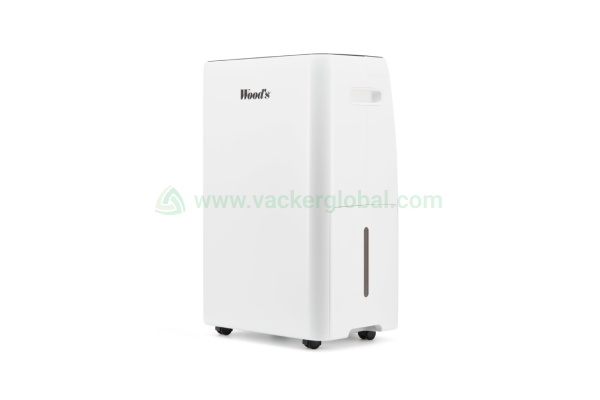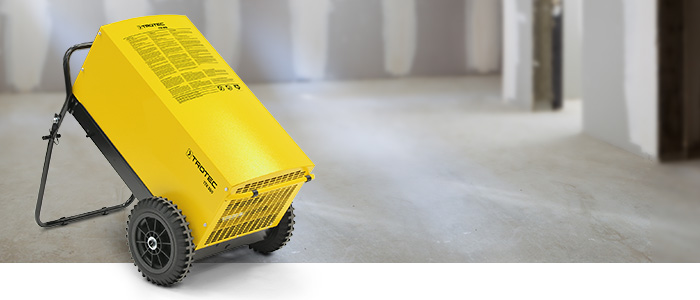
The Mobile Condenser Dryer is suitable for construction drying and water damage restoration for rooms sized up to 800 m³. It has a powerful rotation compressor. This dehumidifier has a robust high-pressure radial fan for the higher performance. It is suitable for dry keeping of rooms sized up to 1,600 m³. You can easily move the device from one place to another. It has wheels and bar handle for this purpose. Upon switching on, the device operates fully automatically. 
This model uses the condensation principle to dehumidify the rooms. It can reduce the relative humidity up to 35% RH in a room.
It is very easy to handle and easy to maintain. The maintenance cost is very low as it has an easily exchangeable and washable air filter. The flow fins distribute the dry air in the room efficiently. Also, it has a high rate of airflow rate with an enormously robust high-pressure radial fan. It is suitable for continuous operation and has an operating hours counter. If you are in a cold-weather country, the hot gas automatic defrost system will be useful. The housing of the device is steel coated housing.
It can operate within a temperature range of 0°C to +40°C and within a relative humidity range of 35% to 100%. The power supply is 230 V/50 Hz. The weight of this mobile condenser dryer is 70 kg excluding packaging.
Applications of Mobile Condenser Dryer, model no. VAC-TTK-800
The following are few of the major applications of our portable condensation type dehumidifier.
- It is useful in power plants for air drying and dehumidification.
- The Mobile Condenser Dryer model VAC-TTK-800 is suitable for data centres and server rooms.
- This air dryer is extremely efficient for warehouses.
- Other applications include factories and production plants.
- The model VAC-TTK-800 can reduce humidity in laboratories.
- Archive centres can use this model for dehumidifying or drying process air.
- Useful in underground plants for dry keeping of air.
- Highly efficient in rooms and areas after water damages from burst pipes of flooring.
- You can use these air dryers in boiler plants for dehumidifying.
- Useful for dry keeping of storerooms sized up to 1,600 m³.
Features of Portable refrigerant type dehumidifier, model no. VAC-TTK-800
Major features of this model are listed below:
- The Mobile Condenser Dryer model VAC-TTK-800 is suitable for construction drying and water damage restoration for rooms sized up to 800 m³.
- VAC-TTK-800 is suitable for dry keeping of rooms sized up to 1,600 m³.
- The device can reduce the relative humidity up to 35%RH in a room.
- This unit operates fully automatically after switching on.
- It is very easy to move around as it has wheels and a bar handle.
- The operating hours counter displays the total duration of the operation.
- VAC-TTK-800 has a hot gas automatic defrost system.
- It has a powerful rotation type compressor.
- It is suitable for use from 0 °C.
- VAC-TTK-800 has an easily exchangeable and washable air filter.
- The power supply of this dehumidifier is 230 V/50 Hz.
- It has a steel coated housing.
Specifications of Mobile Condensation type air dryer model no. VAC-TTK-800 for underground rooms, storerooms and power plants
Specifications of this model are detailed below.
- The dehumidification capacity of the Mobile Condenser Dryer model VAC-TTK-800 is 55 litres per day at 20°C and 60% RH.
- The operating capacity at 30°C/ 80% RH is 110 litre per day.
- This dehumidifier has a maximum drying capacity of 150 litres per day.
- The recommended room size construction drying is 800 m³ or 320 m².
- The recommended room size for dry keeping is 1,600 m³ or 640 m².
- The maximum air volume is 940 m³/h.
- This air dryer can operate between 0 to +40°C and 35% to 100% RH.
- The recommended fusing is 16 A.
- Power requirement for this air dryer for underground rooms is 2.4 kW.
- The mains connection requirement is 230 V/50 Hz.
- The required current starting phase is 37 A.
- The nominal current consumption is 11.4 A.
- The suction side pressure is 0.7 MPa and the discharge side pressure is 2.7 MPa.
- The GWP factor of this refrigerant type dehumidifier for storerooms is 1,774.
- The type of cooling agent is R-407C.
- Amount of cooling agent is 720 g.
- It has a rotary piston compressor.
- CO2 equivalent is 1.277 t.
- Sound value at distance 1 m is 63 dB(A).
- Sound value at distance 3 m is 60 dB(A).
- The weight of this condensation dehumidifier for power plants is 70 kg (packaging excluded).
- The dimensions of this model VAC-TTK-800 is L 585 x W 630 x H 1,020 mm (packaging excluded).
- It has an automatic non-stop dehumidification.
- It has a 1 stage radial fan.
- Analogue hygrostat and hygrostat-control is optionally available.
- The unit has a hot gas automatic defrost system.
- This dehumidifier has a readily accessible and cleanable room air filter.
- Also, it has an operating hours counter.
- It has non-marking full-rubber wheels.
- The housing is a steel coated housing.
- A hose connection is possible for the condensate drain and the recommended hose size is 12 mm.
- A condensate pump is available as an option.
FAQ on dehumidifiers for laboratories
- What is the humidity level required in laboratories? This depends on factors such as the material used in the laboratory, the laboratory equipment etc. In a general living environment, the ideal humidity level is between 40 to 60% RH. However, this is not applicable if you have a material in the laboratory which deteriorates above 40%RH. Hence you have to check the humidity levels specified by the manufacturers of major equipment and major items used for daily operations. Then measure the current humidity levels to decide on the need for a dehumidifier.
- How to reduce humidity in laboratories? In order to reduce humidity, you have to use a dehumidifier. These are air dryers which reduce moisture content in the air. For selecting the right dehumidifier, you should measure the current humidity levels. Also, you should decide the required humidity levels to calculate the right size.
- How to increase humidity in laboratories? In order to increase the humidity, you have to use a humidifier. Humidifiers convert water into moisture and distribute in the air. You should know the current humidity level and the required level to select the right humidifier.
- What is the difference between a humidifier and dehumidifier? A humidifier increases the humidity. A dehumidifier reduces the humidity.
- How to decide whether I should reduce or increase the humidity? First of all, you have to check the required level of humidity based on your application. You can see our general guideline on recommended humidity levels. Then check your current humidity levels using a hygrometer. If you have to reduce the humidity from the current levels, you have to use a dehumidifier. If you have to increase the humidity from the current levels, you have to use a humidifier.
- Is it easy to install a dehumidifier or air dryer? For small to medium rooms, it is easy to install dehumidifiers. Especially condensation dehumidifiers will be easy. They have only a drainage pipe to remove water from the dehumidifier. However, for desiccant type dehumidifiers, you have to install an air outlet to the outside of the building. This will be difficult if your room is not close to the outside air.
- Where to place a dehumidifier in a room? Ideally, keep it as far away as possible from the door. Otherwise, door openings will cause an increase in humidity forcing the machine to work continuously. Also, it is better to keep it away from the direct airflow of an air conditioner or a fan. A direct airflow from other machines will affect the performance of the dehumidifier.
- How to select the right dehumidifier? Based on the type of applications, you have to decide the required level of humidity. You may check our guideline on recommended humidity levels for various applications. Then measure the current humidity. Then you can calculate the required size of a dehumidifier using our free dehumidifier calculation tool.
- How to control humidity in a laboratory? First of all, you have to decide whether to increase humidity or reduce humidity. You can decide this based on the materials handled, equipment used etc. If you want to increase humidity, you have to use a humidifier. In case you have to reduce humidity, you have to use a dehumidifier.
We supply these Mobile condensation type Air Dryers in the Middle East and African countries. Our Dubai office supplies to UAE, Qatar, Oman, Kuwait, Bahrain, Jordan, Lebanon, Iraq, Saudi Arabia etc. Also, we supply to Nigeria, Kenya, Tanzania, Ethiopia, Ghana, Congo, Djibouti, Morocco etc.
